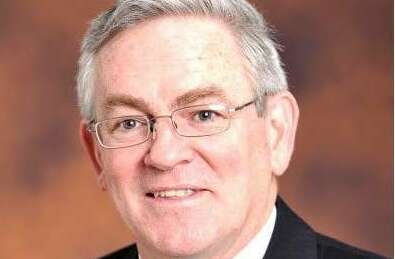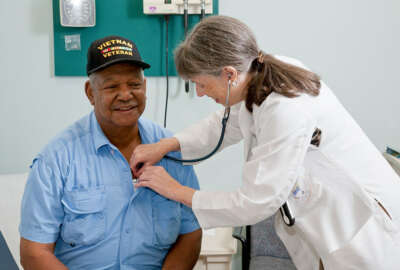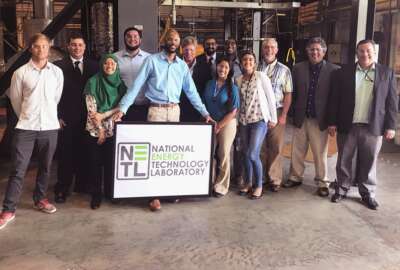
NNSA holding virtual job fair to fill 600 positions
There's no let up in the demand for scientists, engineers and management professionals to staff the nation's nuclear enterprise. NNSA and its contractors are...
Best listening experience is on Chrome, Firefox or Safari. Subscribe to Federal Drive’s daily audio interviews on Apple Podcasts or PodcastOne.
The coronavirus pandemic has made the federal hiring process quite a bit trickier. But there’s no let up in the demand signal for scientists, engineers and management professionals to staff the nation’s nuclear enterprise. Because of that the National Nuclear Security Administration is getting ready to host an all-virtual job fair this Wednesday. NNSA and its contractors are looking to hire about 600 people. For more about the process and how NNSA is managing the hiring process during the pandemic, Federal Drive with Tom Temin spoke to Frank Lowery, the agency’s associate administrator for management.
Interview transcript:
Jared Serbu: I think I’d like to focus first on the virtual aspect of this is. Is this recruiting methodology NNSA developed because of COVID, or have you done these sorts of virtual events before?
Frank Lowery: Thanks, Jared, what a great question. So we’re doing virtual recruiting and have been for about three years here, because it gives us a long arm to reach out to our university partners where we have many graduate students who are doing their doctoral studies and are interested in coming to work at one of our laboratories. Rather than interrupt their doctoral studies at their university, we learned how to do these virtual interviews. So they could continue with their university and interview to get hired at one of our laboratories. So this is old hat for us. What’s different during COVID is that we have shifted entirely to the virtual recruiting events. So we don’t go in-person to the universities anymore because the students mostly are not there. But we do – this is our third effort to do the virtual job fairs, where [we have] run some advertisements out on Twitter and Facebook and LinkedIn and other social media. And then folks can click on the link and sign up for the virtual job fair in advance. And then the day of the virtual job fair, we have our booths – our virtual job fair booths, are manned by hiring managers from both the federal offices here in Washington, D.C, as well as our our laboratory and site partners who are all over the country. So this is going to be a very unique one where we have 600 positions to fill. And we’ll have all of our partners, our management and operation partners from the laboratories and plants. They’ll be with us on Wednesday. And so folks who click on the link and come to our virtual job fair can chat with anybody from one of those different sites, or they can talk to me about opportunities here in Washington, D.C. And we’re excited about the opportunity that’s gonna present here.
Jared Serbu: Yeah, and talk a bit more about that concept of hiring as an enterprise, not just core government jobs but contractor jobs kind of all at once. I can’t think of another agency that does anything quite like that.
Frank Lowery: Sure. So, at NNSA, we have three major product lines, if you can think of it this way we do the nation’s strategic nuclear stockpile. Plus, we do the nation’s defense nuclear non proliferation work around – that’s around the world. Plus, we do the nation’s naval reactors that power our nuclear-powered submarines and our nuclear-powered aircraft carriers. That work doesn’t all happen here in Washington, D.C. In fact, very few people here in Washington – about 2,000 people are in the D.C. area. But we have across our enterprise 50,000 people. We’re bigger than Facebook. And so when we recruit as an enterprise with our management and operation contractors as partners in the recruiting effort, what’s kind of cool is when somebody comes to the job fair, whether it’s physical or virtual, and they’re talking to one of our partners – let’s say the guy from Livermore National Laboratory, and they’re interested in the work we do at Livermore, but they’ve got a family connection in South Carolina. We are very chill about taking that applicant and walking across the ballroom in a in a physical recruiting event, and introducing them to the Savannah River nuclear solutions team from Savannah River, South Carolina, and allowing Savannah River to recruit and hire that person, because they probably were not going to be super I’m happy and able to flourish in Livermore if they’re trying to get back home to Mom and Dad in South Carolina. And so we have found success by recruiting as an enterprise, because we can fill in the gaps from one candidate who may be perfect technically for the work we have to do at Livermore National Laboratory, but whole life -wise for that person to flourish and be really fulfilled in life, they need to be in Savannah River right now. And so we can hire them there. We’ll hire ’em in Savannah River, they can move through our enterprise. They can go – from Savannah River, they could go to Livermore, they could go to Los Alamos, New Mexico; they could go to Sandia National Laboratory in New Mexico. They could go to our Pantex Plant in Amarillo, Texas; they could go to our Kansas City plant in Missouri, they could go to Oak Ridge, Tennessee, and work at Y-12. We allow and in fact encourage people to move within the enterprise to learn more about how we do our product line, and to help us manage as smartly as possible by bringing the best practices from one of our M&Os to the other M&Os, and vice versa. Jared, so thank you – does that scratch that itch?
Jared Serbu: It does. And I’m just curious, you mentioned 600 positions in this go around. Is that an unusually high number or par for the course? And then within that, what are sort of the most challenging types of positions historically for an NNSA to actually fill?
Frank Lowery: Yeah, that’s a great question. So in this fiscal year, fiscal year 2020, our targets, so our hiring needs across the enterprise were approximately 6,000 people. And there’s really two things working here. One, we have many people in our workforce of 50,000, many of them are retirement-eligible or soon will be, and you can think about roughly one-third of us will be retirement-eligible in the next five years. That’s just managing attrition of people who are moving on to the next chapter of their life after having served the country for decades. In addition to that Jared, there is some growth in the work that we’re doing for the country. And that’s budget increases for the NNSA product line which we we produce for the Department of Defense. We also have to continue to hire scientists, engineers, program managers, project managers, accountants, health physicists, the whole spectrum of federal and M&O, or contractor employees. We’re hiring all types. Now to your specific question of what’s our most challenging, it is very challenging these days, because we have to compete with private enterprise and with every other federal agency out there. It’s very challenging for us to find the engineer and the physical scientist who can come and be with us for decades and help us continue this mission. And so we we do work very hard through our university connections, to try to stay in touch with the current student body, both undergraduate and graduate, so that as they finish up their studies and have a summer, they can come with us and do an internship at one of our national labratories, a paid internship, and if the paid internship goes well they may come again next summer. And if they really like it a lot, they may come back after they graduate, and become one of our research scientists at one of the National Laboratories. So we are very excited about the virtual job fair on Wednesday. Again, it runs from 10-4. And it’s easy to find, if you Google “NNSA virtual job fair August” it’s the first thing to pop. And while you’ll find when you click on the link it’ll ask you some questions, you can upload a resume. And when you go on Wednesday to the job, the virtual job fair and you get in the door, you’ll see all these booths, and you can click on a booth for Lawrence Livermore National Laboratory. And there’ll be an informative video that you can click on and watch and it will tell you all about what we do at Livermore. There’ll be a different booth labeled Los Alamos National Laboratory. If you click on the other icon in that booth, it’ll give you the opportunity to talk to a person who actually works at the Lawrence Livermore or the Los Alamos National Laboratory, whichever one you clicked on. And if the booth has got people in it, like there’s already people in there chatting, it’ll keep track of when you enter the booth, and it will take care of you in the priority order based on what time you clicked on that link to get in the booth. So I’m excited about it. I think my friends here who are going to be doing the hiring efforts on Wednesday, they’re excited about it. Because we’ve already done two of these, we’ve had great success in hiring people virtually. They don’t have to come in, they don’t have to risk COVID. They don’t have to even come in to do the virtual onboarding. We do all that remotely, and we can get them working for us from their house.
Jared Serbu: And lastly I wanted to ask you about the timeline of that process. I mean, obviously, the federal government has a well-deserved reputation for being a slow hire. I’m sure a lot of these positions also require security clearances, if not all of them. So realistically, I mean, if somebody has a good interview on Wednesday, when are they actually going to be working?
Frank Lowery: Great question, Jared. So we were – going off a virtual job fair that we ran this summer, so this is recent data, we ran one in June, we ran one in July. And we’ve already onboarded 14 people – scientists and engineers – from the June job fair and we have 20 people lined up to come on board from the July job fair. The limitation doesn’t end up being things like fingerprinting and the like. It’s true, you used to have to do all of that stuff before you can hire the person and get them on the payroll. But because of the COVID, the Office of Personnel Management has given us some latitude on how we can bring people on board and get them working. And so they can come on board and begin working on their unclassified training. They can take the mandatory classes that everyone has to take to learn more about how we do our cybersecurity, and how we treat private information that, you know, can’t be released outside into the public domain. There are a multitude of unclassified training opportunities that we can knockout while we work through the security clearance process, and so we don’t let that impede our onboarding date. And that’s been very exciting because a lot of the people who are out there interested in coming to work for us, otherwise might go work somewhere else. And we don’t want that. We want them to come with us. We need them for our mission and we’re excited about getting them on board as quickly as we can. So to answer your question more directly, those folks that came to the June job fair, they’re already on board.
Jared Serbu: That’s Frank Lowery, the associate administrator for management at the National Nuclear Security Administration. We’ll post the sign-up link for Wednesday’s virtual job fair at FederalNewsNetwork.com/FederalDrive.
Copyright © 2025 Federal News Network. All rights reserved. This website is not intended for users located within the European Economic Area.
Tom Temin is host of the Federal Drive and has been providing insight on federal technology and management issues for more than 30 years.
Follow @tteminWFED
Related Stories





